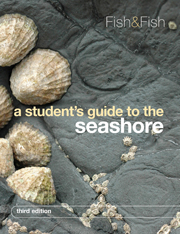Book contents
- Frontmatter
- Contents
- Preface
- Acknowledgements for illustrations
- Introduction
- Design and layout of the book
- Illustrated guide to the plants and animals of the shore
- Seaweeds
- Lichens
- Anthophyta
- Porifera
- Cnidaria
- Ctenophora
- Platyhelminthes
- Nemertea
- Priapula
- Annelida
- Mollusca
- Arthropoda
- Sipuncula
- Echiura
- Bryozoa
- Phoronida
- Echinodermata
- Hemichordata
- Chordata
- Bibliography
- Glossary
- Index
- Plate section
- References
Bryozoa
Published online by Cambridge University Press: 05 June 2012
- Frontmatter
- Contents
- Preface
- Acknowledgements for illustrations
- Introduction
- Design and layout of the book
- Illustrated guide to the plants and animals of the shore
- Seaweeds
- Lichens
- Anthophyta
- Porifera
- Cnidaria
- Ctenophora
- Platyhelminthes
- Nemertea
- Priapula
- Annelida
- Mollusca
- Arthropoda
- Sipuncula
- Echiura
- Bryozoa
- Phoronida
- Echinodermata
- Hemichordata
- Chordata
- Bibliography
- Glossary
- Index
- Plate section
- References
Summary
Bryozoans are small, colonial animals found mainly in marine environments although a few species are present in fresh water. They are almost all sessile and occur in a variety of shapes and sizes on substrata such as seaweeds, rocks, stones and shells, both intertidally and sublittorally, sometimes in high densities. Each individual in the colony is known as a zooid and is usually no more than a millimetre in length. The zooids are surrounded by a cuticle which is often strengthened by calcareous material. One of the most characteristic features of bryozoans is the lophophore, a group of ciliated tentacles which encircles the mouth and collects microorganisms such as bacteria and diatoms on which the animals feed. Ciliated tentacles distinguish bryozoans from hydroids, with which they may be confused. In hydroids the tentacles lack cilia. The lophophore projects through an aperture in the cuticle and in some species this is closed by an operculum or by contraction of muscles. The alimentary canal is U-shaped with the anus outside the lophophore. Other groups of invertebrates have a lophophore and these include the phylum Phoronida (p. 394) and the phylum Brachiopoda, marine benthic invertebrates in which the body is enclosed by two shell valves. In some texts the bryozoans, the phoronids and the brachiopods are grouped together as the lophophorates, but see p. 394.
- Type
- Chapter
- Information
- A Student's Guide to the Seashore , pp. 382 - 393Publisher: Cambridge University PressPrint publication year: 2011



